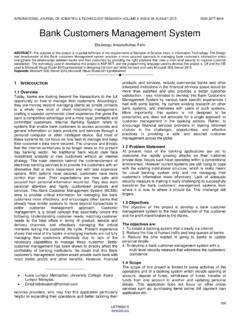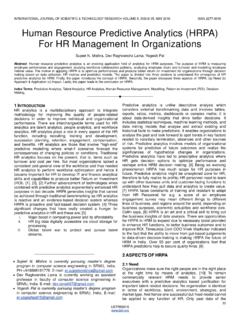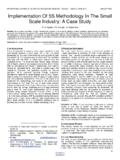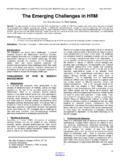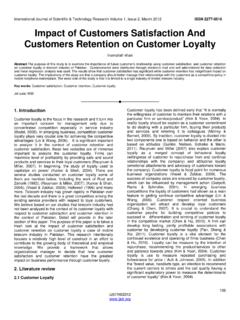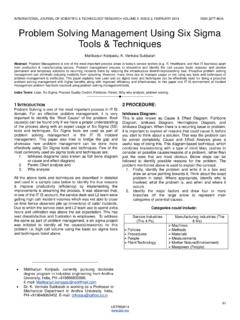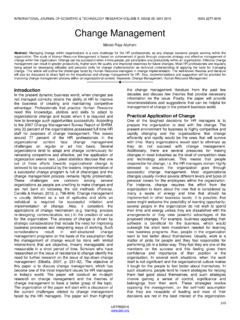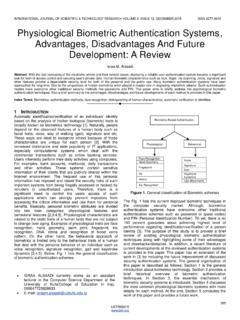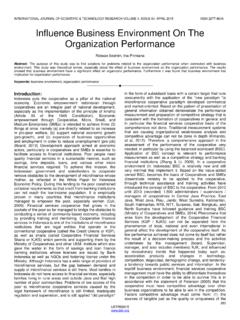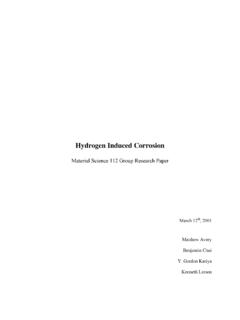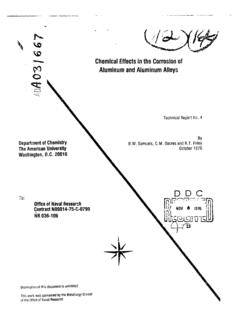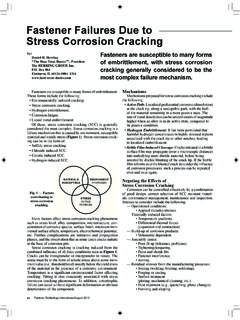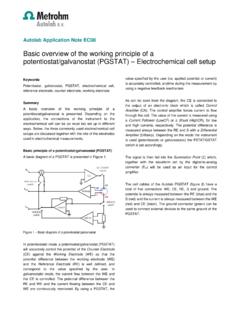Transcription of INTERNATIONAL JOURNAL OF SCIENTIFIC & TECHNOLOGY …
1 INTERNATIONAL JOURNAL OF SCIENTIFIC & TECHNOLOGY RESEARCH VOLUME 3, ISSUE 7, JULY 2014 ISSN 2277-8616 306 IJSTR 2014 Investigation Of The Effect Of corrosion On Mild Steel In Five Different Environments Chinwko Emmanuel Chuka, Odio B. O., Chukwuneke J. L., Sinebe J. E. Abstract: Mild Steel is one of the major construction materials used in the industries. It has a young modulus of 200 GNm-2. This paper focuses on the experimental study of the corrosion behavior and mechanism for mild steel in five different media namely: of Hydrochloric acid, Underground (soil), Atmosphere, Salt water, Fresh water. Mild steel of diameter and long was used for this experiment and studied for a period of five weeks interval weighing and re-immersing. The weight losses were tabulated and analyzed graphically. It was observed that mild steel corroded in the different environments with decreasing intensity in the order of of Hydrochloric acid, Underground (soil), Atmosphere, Salt water, Fresh water.
2 It was then concluded that the laboratory immersion test remains the best method of screening of metal, it remains the quickest and most economical means for providing a preliminary selection of best suited materials for engineering applications as there is no simple way to extrapolate the results obtained from this simple test to the predictions of systems service lifetime. Index Terms: Atmosphere, corrosion , Different Environments, Engineering applications, Fresh water, Hydrochloric acid, Metals, Mild steel, Salt water, Underground (soil). 1 INTRODUCTION IN the world today, mild steel is used in different Engineering applications for the production of some automobile components, structural shapes (I beam and angle iron) and sheets that are used in pipelines, buildings, plants, bridges and tin cans [1].
3 Mild steel is known for its high carbon content of about to , manganese ( ), copper ( ), silicon ( ). It is produced from steel which is extracted from pig iron it is also less expensive to produce and is readily available. It has outstanding ductility and toughness, high machinability and weldability which make its applications possible in the engineering fields. The application for which mild steel was developed generally did not involve corrosion resistance as a primary consideration; corrosion resistance of metals and alloys is a basic property related to the ease with which these metals react with a given environment. With the increased utilization of this metal in the manufacturing and construction firms, one of the major problems encountered is the control of corrosion rate when exposed to different corrosive environments.
4 corrosion is a natural process that reduces the binding energy in metals with the end result involving a metal being oxidized as the bulk metal looses one or more electrons. The lost electrons are conducted through the bulk metal to another site where they are reduced. In corrosion , the site where the metal atom looses electron is called the anode and the reducing species is called the cathode. Also, corrosion can be said to be the degradation of metallic materials properties due to interactions with its environments. corrosion of most metals is inevitable while primarily associated with metallic materials, all material types are susceptible to degradation. Most metals in contact with water (and moisture in air), acids, bases salts, oils, oppressive metal polishes and other solid and liquid chemicals corrode as well as when exposed to gaseous materials like acid vapors, ammonia gas and sulphur containing gases.
5 corrosion processes are usually electrochemical in nature, having the essential features of a battery. When metal atoms are exposed to an environment containing water molecules they can give up electrons becoming themselves positively charged ions provided an electric circuit can be well extended across a wide area to produce general wastage. All metals exhibit the tendency to oxidize, some more easily than the others. A tabulation of the relative strength of this tendency is the galvanic series. The knowledge of a metal's position in this series helps in decision making for appropriate potential utility of a metal in structural and other applications. In a corrosion cell, the electron produced by the corrosion reaction will need to be consumed by a cathodic reaction in close proximity to the corrosion reaction itself.
6 The electron and the hydrogen ions react to first form atomic hydrogen and then molecular hydrogen gas. As the hydrogen forms, it tends to inhibit further corrosion by forming a very thin gaseous film at the surface of the metal. This film can be effective in reducing metal to water contact and thus reducing corrosion rate. Dissolved oxygen in water will react with the hydrogen, converting it to water thus destroying the film. When the fresh metal is exposed to water, high water velocities can also sweep film away. Other corrosion accelerating actors includes; pH values and high temperature which increase virtually all chemical reactions. Thus a variety of natural and environmental factors can have significant effect on the corrosion of metals even when no other special conditions are involved [2, 3].
7 In most situations its serviceability depends on the fact that following the initial corrosive attack, protective films are formed that tend to reduce the corrosion rate to some acceptable level [4, 5]. For the effective use of this steel in different engineering applications, there is the need to consider the corrosion rate engulfing this metal. The approach geared towards this _____ Odio B. O. is currently pursuing masters degree program in Industrial and Production Engineering in Nnamdi Azikiwe University, Nigeria. Chinwuko E. C. is currently a senior lecturer in Industrial and Production Engineering in Nnamdi Azikiwe University, Nigeria. Chukwuneke J. L. is currently pursuing doctorate degree program in Mechanical Engineering in Nnamdi Azikiwe University, Nigeria.
8 E-mail: Sinebe J. E. is currently pursuing doctorate degree program in Mechanical Engineering in Nnamdi Azikiwe University, Nigeria. INTERNATIONAL JOURNAL OF SCIENTIFIC & TECHNOLOGY RESEARCH VOLUME 3, ISSUE 7, JULY 2014 ISSN 2277-8616 307 IJSTR 2014 phenomenon involves a basic knowledge of the structural features of the metal, the component data of the corrosion reaction that occurs at the metal environment interface. This enquiry is obviously necessary because corrosion reduces the useful life of plants and equipment and can often result in unscheduled shutdowns or in some cases, catastrophic failure [4, 6, 7]. The control of corrosion presents a considerable challenge to engineers and in spite of our best effort, the annual costs of corrosion damage and maintenance run into many millions of Great British Pounds (GBP), estimated at about 4% of the GNP for an industrial country.
9 This consequence is as a result of the location of these industries, structures and metals which are mostly at marine environments and have their atmosphere polluted by corrosion pollutant gases [8]. corrosion is a natural phenomenon, which is inevitable; instead it can be controlled to an appreciable extent. For this control to be implemented, certain tests are carried out by placing the metal in the environment to which it's utility is needed and a careful study of the metal is undergone for a specified time, based on the observation and inference drawn, the corrosion rate can be assessed and a proper measure can be made to control the rate of corrosion [9]. This paper tends to study the effects and rate of corrosion of the mild steel in five different environments namely: of Hydrochloric acid, Underground (soil), Atmosphere, Salt water, Fresh water and to examine the chemistry and mechanism of mild steel corrosion , to indicate the environment in which a mild steel rod may be used satisfactorily, and to determine the kinetics of corrosion of mild steel so that predictions of service life can be made and contributions can be made towards the utmost control of corrosion processes.
10 The significance of this study is to determine and provide a comparative analysis on the rate at which mild steel corrodes in the five different environments and as a result re-awakening the readiness of the material engineering to control this rate of corrosion thereby increasing the service life of mild steel when used in any of the environments. 2 METHOD AND MATERIAL Similar sizes of mild steel were exposed to different corrosive environments and were left for a stipulated period of five weeks with a weekly interval of collection, weighing and re-immersing into the various environments. Note; based on standard practice, the liquid media are changed at the time of reweighing and re-immersing. Based on the weight assessment, appropriate corrosion formulae are employed to ascertain reliable analysis.
